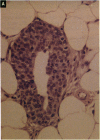Abstract
Breast cancer, the most frequent spontaneous malignancy diagnosed in women in the western world, is continuously increasing in incidence in industrialized nations. Although breast cancer develops in women as the result of a combination of external and endogenous factors such as exposure to ionizing radiation, diet, socioeconomic status, and endocrinologic, familial, or genetic factors, no specific etiologic agent(s) or the mechanisms responsible of the disease has been identified as yet. Thus, experimental models that exhibit the same complex interactions are needed for testing various mechanisms and for assessing the carcinogenic potential of given chemicals. Rodent mammary carcinomas represent such a model to a great extent because, in these species, mammary cancer is a multistep complex process that can be induced by either chemicals, radiation, viruses, or genetic factors. Long-term studies in rodent models have been particularly useful for dissecting the initiation, promotion, and progression steps of carcinogenesis. The susceptibility of the rodent mammary gland to develop neoplasms has made this organ a unique target for testing the carcinogenic potential of specific genotoxic chemicals and environmental agents. Mammary tumors induced by indirect- or direct-acting carcinogens such as 7, 12-dimethlbenz(a)anthracene or N-methyl-N-nitrosourea are, in general, hormone dependent adenocarcinomas whose incidence, number of tumors per animal, tumor latency, and tumor type are influenced by the age, reproductive history, and endocarinologic milieu of the host at the time of carcinogen exposure. Rodent models are informative in the absence of human data. They have provided valuable information on the dose and route of administration to be used and optimal host conditions for eliciting maximal tumorigenic response. Studies of the influence of normal gland development on the pathogenesis of chemically induced mammary carcinomas have clarified the role of differentiation in cancer initiation. Comparative studies with the development of the human breast and the pathogenesis of breast cancer have contributed to validate rodent-to-human extrapolations. However, it has not been definitively established what type of information is necessary for human risk assessment, whether currently toxicity testing methodologies are sufficient for fulfilling those needs, or whether treatment-induced tumorigenic responses in rodents are predictive of potential human risk. An alternative to the traditional bioassays are mechanism-based toxicology and molecular and cellular approaches, combined with comparative in vitro systems. These approaches might allow the rapid screen of chemicals for setting priorities for further studies to determine the dose-response relationship for chemical effects at low doses, to assess effects other than mutagenesis and/or tumorigenesis, or to establish qualitative and quantitative relationships of biomarkers to toxic effects. Until there is enough information on the predictive value of mechanism-based toxicology for risk assessment, this approach should be used in conjunction with and validated by the traditional in vivo long-term bioassays.
Full text
PDF










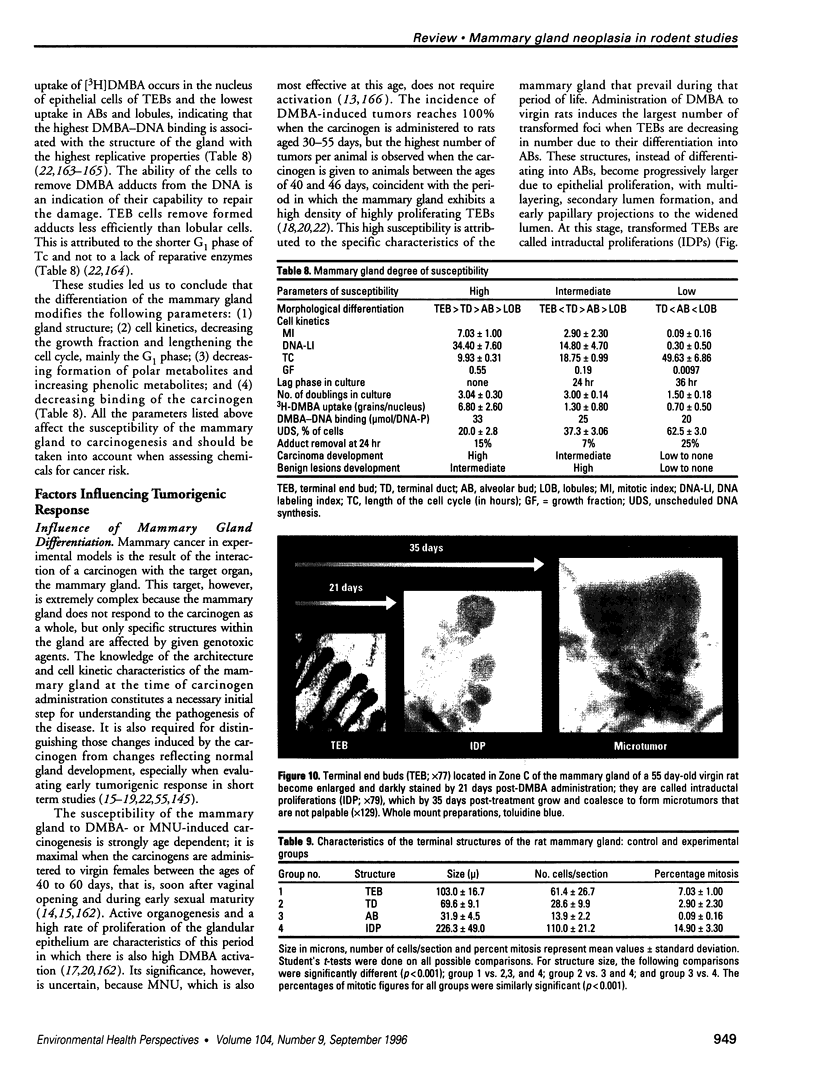



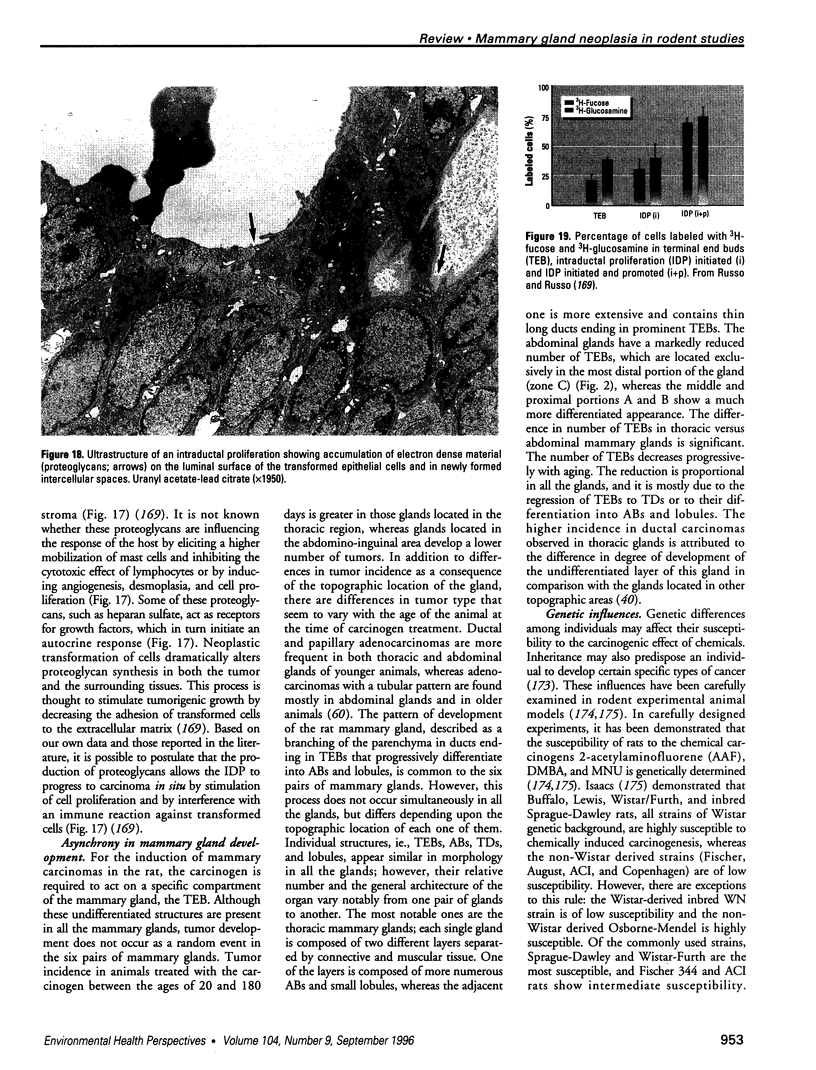



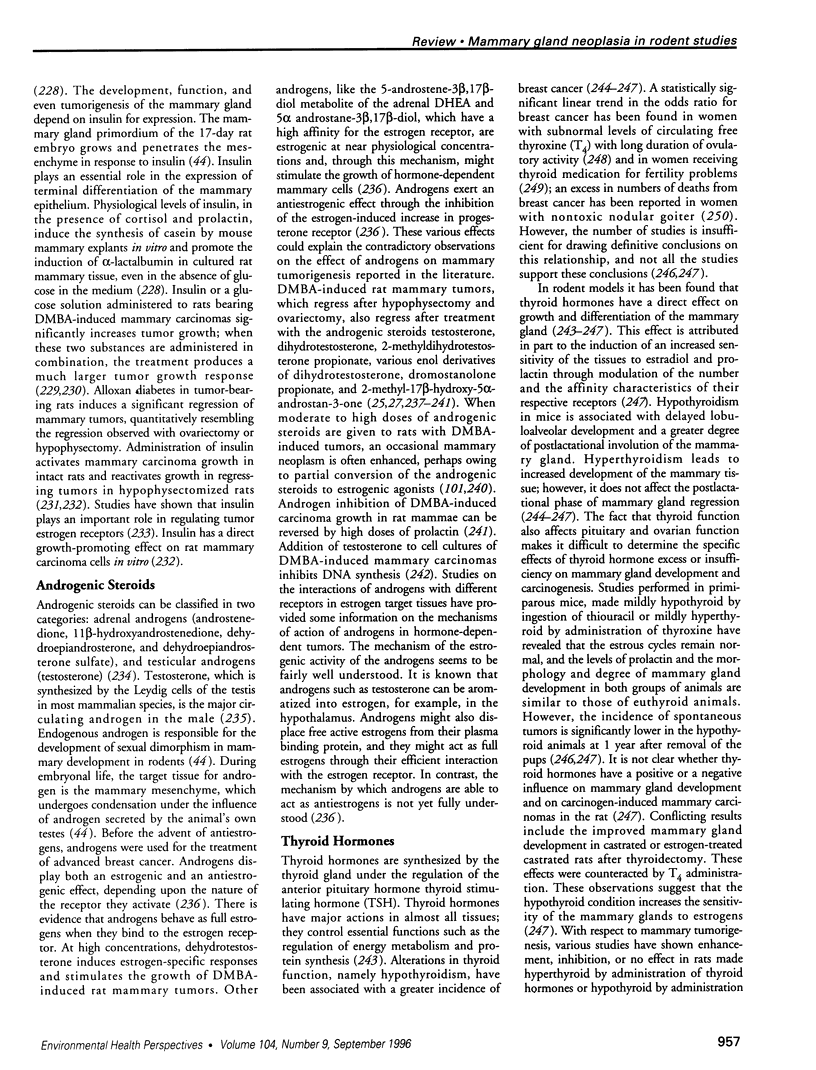


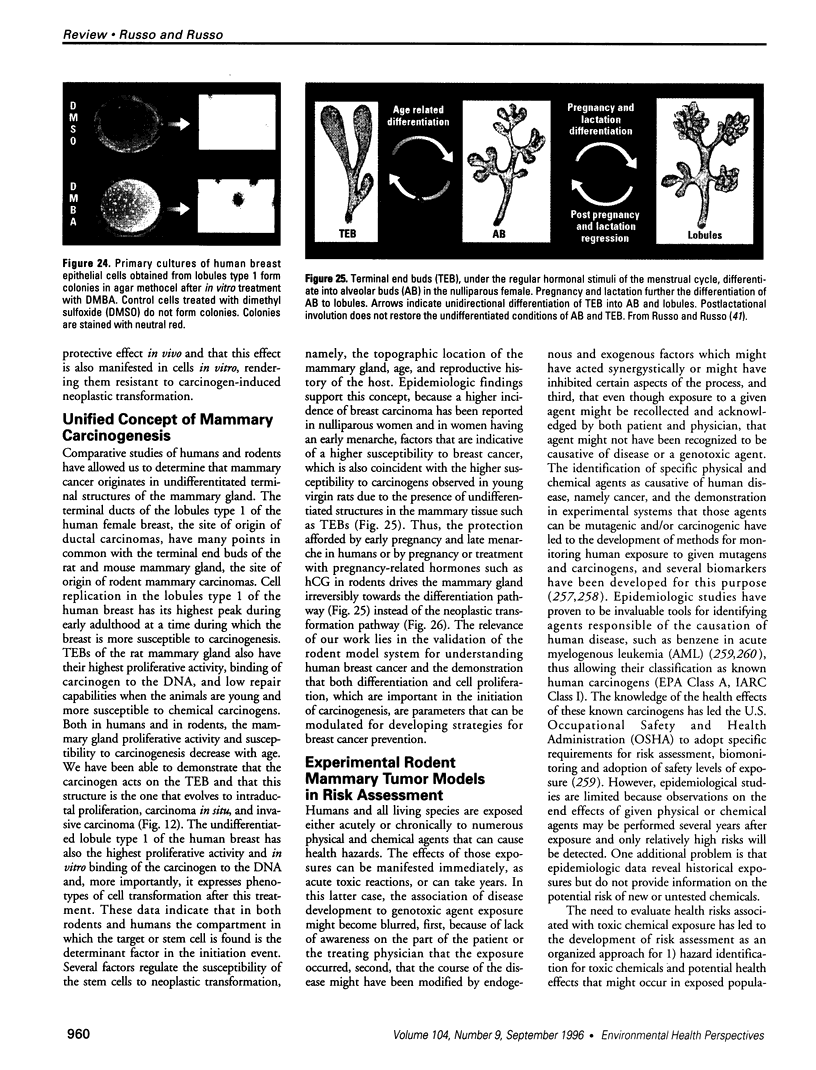



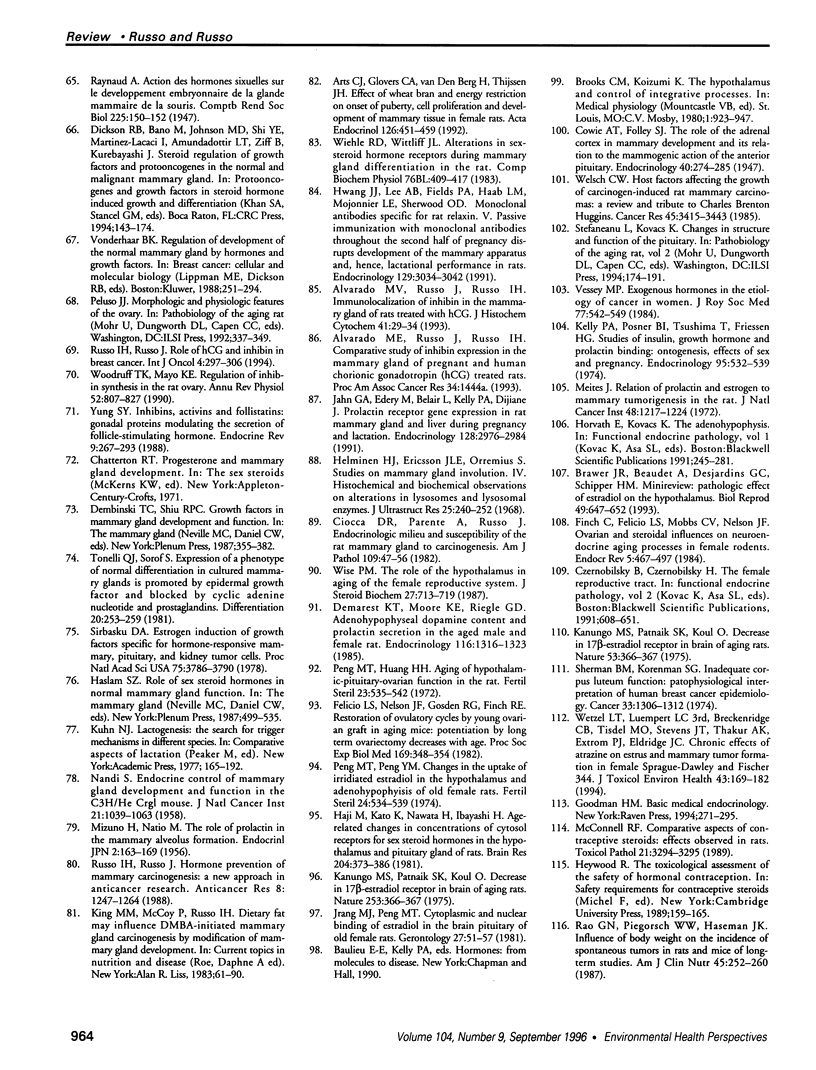


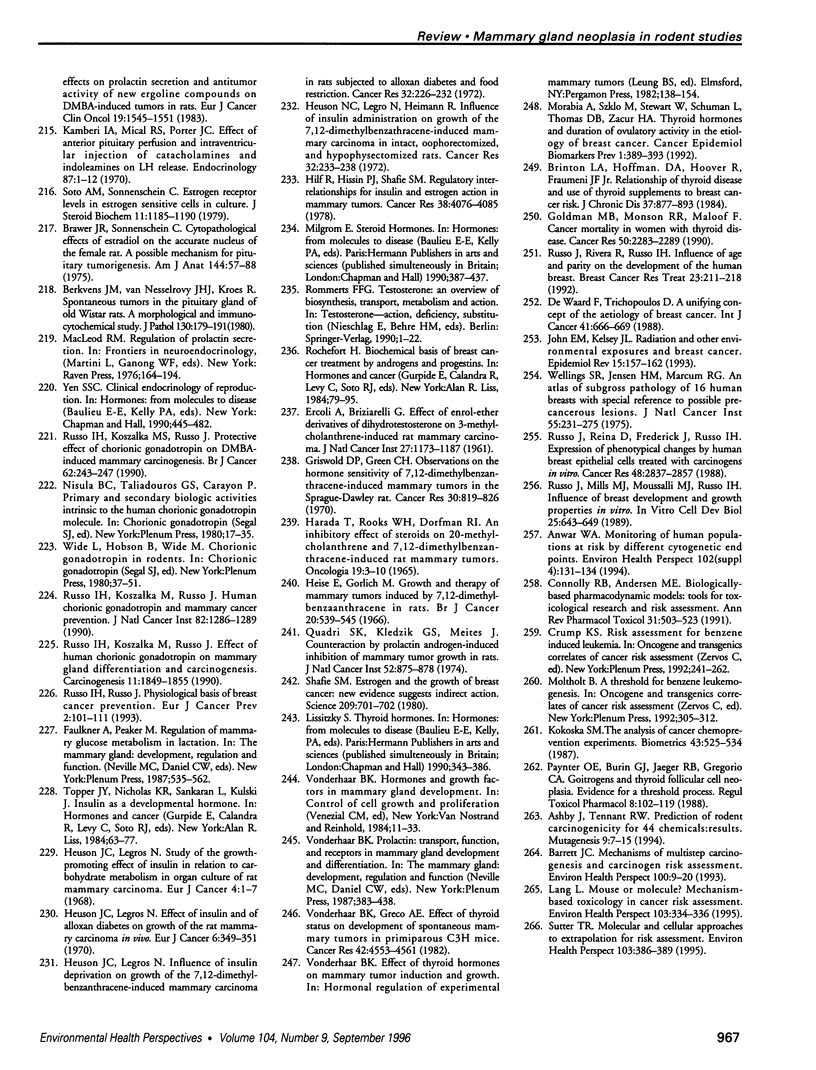
Images in this article
Selected References
These references are in PubMed. This may not be the complete list of references from this article.
- Alvarado M. V., Russo J., Russo I. H. Immunolocalization of inhibin in the mammary gland of rats treated with hCG. J Histochem Cytochem. 1993 Jan;41(1):29–34. doi: 10.1177/41.1.8417109. [DOI] [PubMed] [Google Scholar]
- Anwar W. A. Monitoring of human populations at risk by different cytogenetic end points. Environ Health Perspect. 1994 Oct;102 (Suppl 4):131–134. doi: 10.1289/ehp.94102s4131. [DOI] [PMC free article] [PubMed] [Google Scholar]
- Arts C. J., Govers C. A., van den Berg H., Thijssen J. H. Effects of wheat bran and energy restriction on onset of puberty, cell proliferation and development of mammary tissue in female rats. Acta Endocrinol (Copenh) 1992 May;126(5):451–459. doi: 10.1530/acta.0.1260451. [DOI] [PubMed] [Google Scholar]
- Ashby J., Tennant R. W. Prediction of rodent carcinogenicity for 44 chemicals: results. Mutagenesis. 1994 Jan;9(1):7–15. doi: 10.1093/mutage/9.1.7. [DOI] [PubMed] [Google Scholar]
- Aylsworth C. F., Cullum M. E., Zile M. H., Welsch C. W. Influence of dietary retinyl acetate on normal rat mammary gland development and on the enhancement of 7,12-dimethylbenz[a]anthracene-induced rat mammary tumorigenesis by high levels of dietary fat. J Natl Cancer Inst. 1986 Feb;76(2):339–345. [PubMed] [Google Scholar]
- BOND V. P., CRONKITE E. P., LIPPINCOTT S. W., SHELLABARGER C. J. Studies on radiation-induced mammary gland neoplasia in the rat. III. Relation of the neoplastic response to dose of total-body radiation. Radiat Res. 1960 Mar;12:276–285. [PubMed] [Google Scholar]
- BOND V. P., SHELLABARGER C. J., CRONKITE E. P., FLIEDNER T. M. Studies on radiation-induced mammary gland neoplasia in the rat. 5. Induction by localized irradiation. Radiat Res. 1960 Aug;13:318–328. [PubMed] [Google Scholar]
- Barrett J. C. Mechanisms of multistep carcinogenesis and carcinogen risk assessment. Environ Health Perspect. 1993 Apr;100:9–20. doi: 10.1289/ehp.931009. [DOI] [PMC free article] [PubMed] [Google Scholar]
- Beth M., Berger M. R., Aksoy M., Schmähl D. Comparison between the effects of dietary fat level and of calorie intake on methylnitrosourea-induced mammary carcinogenesis in female SD rats. Int J Cancer. 1987 Jun 15;39(6):737–744. doi: 10.1002/ijc.2910390614. [DOI] [PubMed] [Google Scholar]
- Bittner J. J. THE MILK-INFLUENCE OF BREAST TUMORS IN MICE. Science. 1942 May 1;95(2470):462–463. doi: 10.1126/science.95.2470.462. [DOI] [PubMed] [Google Scholar]
- Blankenstein M. A., Broerse J. J., van Zwieten M. J., van der Molen H. J. Prolactin concentration in plasma and susceptibility to mammary tumors in female rats from different strains treated chronically with estradiol-17 beta. Breast Cancer Res Treat. 1984;4(2):137–141. doi: 10.1007/BF01806396. [DOI] [PubMed] [Google Scholar]
- Brawer J. R., Beaudet A., Desjardins G. C., Schipper H. M. Pathologic effect of estradiol on the hypothalamus. Biol Reprod. 1993 Oct;49(4):647–652. doi: 10.1095/biolreprod49.4.647. [DOI] [PubMed] [Google Scholar]
- Brawer J. R., Sonnenschein C. Cytopathological effects of estradiol on the arcuate nucleus of the female rat. A possible mechanism for pituitary tumorigenesis. Am J Anat. 1975 Sep;144(1):57–88. doi: 10.1002/aja.1001440105. [DOI] [PubMed] [Google Scholar]
- Brinton L. A., Hoffman D. A., Hoover R., Fraumeni J. F., Jr Relationship of thyroid disease and use of thyroid supplements to breast cancer risk. J Chronic Dis. 1984;37(12):877–893. doi: 10.1016/0021-9681(84)90062-6. [DOI] [PubMed] [Google Scholar]
- Broerse J. J., Hennen L. A., Klapwijk W. M., Solleveld H. A. Mammary carcinogenesis in different rat strains after irradiation and hormone administration. Int J Radiat Biol Relat Stud Phys Chem Med. 1987 Jun;51(6):1091–1100. doi: 10.1080/09553008714551381. [DOI] [PubMed] [Google Scholar]
- Broerse J. J., Hennen L. A., Solleveld H. A. Actuarial analysis of the hazard for mammary carcinogenesis in different rat strains after X- and neutron irradiation. Leuk Res. 1986;10(7):749–754. doi: 10.1016/0145-2126(86)90291-2. [DOI] [PubMed] [Google Scholar]
- Chan P. C., Dao T. L. Effects of dietary fat on age-dependent sensitivity to mammary carcinogenesis. Cancer Lett. 1983 Apr;18(3):245–249. doi: 10.1016/0304-3835(83)90232-x. [DOI] [PubMed] [Google Scholar]
- Ciocca D. R., Parente A., Russo J. Endocrinologic milieu and susceptibility of the rat mammary gland to carcinogenesis. Am J Pathol. 1982 Oct;109(1):47–56. [PMC free article] [PubMed] [Google Scholar]
- Clinton S. K., Imrey P. B., Alster J. M., Simon J., Truex C. R., Visek W. J. The combined effects of dietary protein and fat on 7,12-dimethylbenz(a)anthracene-induced breast cancer in rats. J Nutr. 1984 Jul;114(7):1213–1223. doi: 10.1093/jn/114.7.1213. [DOI] [PubMed] [Google Scholar]
- Cohen L. A., Thompson D. O., Maeura Y., Choi K., Blank M. E., Rose D. P. Dietary fat and mammary cancer. I. Promoting effects of different dietary fats on N-nitrosomethylurea-induced rat mammary tumorigenesis. J Natl Cancer Inst. 1986 Jul;77(1):33–42. [PubMed] [Google Scholar]
- Conolly R. B., Andersen M. E. Biologically based pharmacodynamic models: tools for toxicological research and risk assessment. Annu Rev Pharmacol Toxicol. 1991;31:503–523. doi: 10.1146/annurev.pa.31.040191.002443. [DOI] [PubMed] [Google Scholar]
- DAO T. L. The role of ovarian hormones in initiating the induction of mammary cancer in rats by polynuclear hydrocarbons. Cancer Res. 1962 Sep;22:973–981. [PubMed] [Google Scholar]
- Dao T. L., Chan P. C. Effect of duration of high fat intake on enhancement of mammary carcinogenesis in rats. J Natl Cancer Inst. 1983 Jul;71(1):201–205. [PubMed] [Google Scholar]
- Demarest K. T., Moore K. E., Riegle G. D. Adenohypophysial dopamine content and prolactin secretion in the aged male and female rat. Endocrinology. 1985 Apr;116(4):1316–1323. doi: 10.1210/endo-116-4-1316. [DOI] [PubMed] [Google Scholar]
- Dvorak H. F., Dvorak A. M. Basophils, mast cells, and cellular immunity in animals and man. Hum Pathol. 1972 Dec;3(4):454–456. doi: 10.1016/s0046-8177(72)80004-2. [DOI] [PubMed] [Google Scholar]
- ERCOLI A., BRIZIARELLI G. Effect of enol-ether derivatives of dihydrotestosterone on 3-methylcholanthrene-induced rat mammary carcinoma. J Natl Cancer Inst. 1961 Nov;27:1173–1187. [PubMed] [Google Scholar]
- FINERTY J. C., BINHAMMER R. T., SCHNEIDER M., CUNNINGHAM A. W. Neoplasms in rats exposed to single-dose total-body X radiation. J Natl Cancer Inst. 1953 Aug;14(1):149–157. [PubMed] [Google Scholar]
- Finch C. E., Felicio L. S., Mobbs C. V., Nelson J. F. Ovarian and steroidal influences on neuroendocrine aging processes in female rodents. Endocr Rev. 1984 Fall;5(4):467–497. doi: 10.1210/edrv-5-4-467. [DOI] [PubMed] [Google Scholar]
- Folkman J. How is blood vessel growth regulated in normal and neoplastic tissue? G.H.A. Clowes memorial Award lecture. Cancer Res. 1986 Feb;46(2):467–473. [PubMed] [Google Scholar]
- Formelli F., Zaccheo T., Di Salle E., Ornati G., Di Marco A. Correlation between inhibitory effect on prolactin secretion and antitumor activity of new ergoline compounds on DMBA-induced tumors in rats. Eur J Cancer Clin Oncol. 1983 Nov;19(11):1545–1551. doi: 10.1016/0277-5379(83)90084-6. [DOI] [PubMed] [Google Scholar]
- Gapstur S. M., Potter J. D., Sellers T. A., Folsom A. R. Increased risk of breast cancer with alcohol consumption in postmenopausal women. Am J Epidemiol. 1992 Nov 15;136(10):1221–1231. doi: 10.1093/oxfordjournals.aje.a116430. [DOI] [PubMed] [Google Scholar]
- Goldman M. B., Monson R. R., Maloof F. Cancer mortality in women with thyroid disease. Cancer Res. 1990 Apr 15;50(8):2283–2289. [PubMed] [Google Scholar]
- Griswold D. P., Jr, Green C. H. Observations on the hormone sensitivity of 7,12-dimethylbenz(alpha)anthracene-induced mammary tumors in the Sprague-Dawley rat. Cancer Res. 1970 Mar;30(3):819–826. [PubMed] [Google Scholar]
- Grubbs C. J., Hill D. L., McDonough K. C., Peckham J. C. N-nitroso-N-methylurea-induced mammary carcinogenesis: effect of pregnancy on preneoplastic cells. J Natl Cancer Inst. 1983 Sep;71(3):625–628. [PubMed] [Google Scholar]
- Gullino P. M., Pettigrew H. M., Grantham F. H. N-nitrosomethylurea as mammary gland carcinogen in rats. J Natl Cancer Inst. 1975 Feb;54(2):401–414. [PubMed] [Google Scholar]
- HARADA T., ROOKS W. H., 2nd, DORFMAN R. I. AN INHIBITORY EFFECT OF STEROIDS ON 20-METHYLCHOLANTHRENE- AND 7,12-DIMETHYLBENZ(A)-ANTHRACENE-INDUCED RAT MAMMARY TUMORS. Oncology. 1965;19:3–10. doi: 10.1159/000224279. [DOI] [PubMed] [Google Scholar]
- HUGGINS C., GRAND L. C., BRILLANTES F. P. Mammary cancer induced by a single feeding of polymucular hydrocarbons, and its suppression. Nature. 1961 Jan 21;189:204–207. doi: 10.1038/189204a0. [DOI] [PubMed] [Google Scholar]
- HUGGINS C., MOON R. C., MORII S. Extinction of experimental mammary cancer. I. Estradiol-17beta and progesterone. Proc Natl Acad Sci U S A. 1962 Mar 15;48:379–386. doi: 10.1073/pnas.48.3.379. [DOI] [PMC free article] [PubMed] [Google Scholar]
- HUGGINS C., YANG N. C. Induction and extinction of mammary cancer. A striking effect of hydrocarbons permits analysis of mechanisms of causes and cure of breast cancer. Science. 1962 Jul 27;137(3526):257–262. doi: 10.1126/science.137.3526.257. [DOI] [PubMed] [Google Scholar]
- Haji M., Kato K. I., Nawata H., Ibayashi H. Age-related changes in the concentrations of cytosol receptors for sex steroid hormones in the hypothalamus and pituitary gland of the rat. Brain Res. 1981 Jan 12;204(2):373–386. doi: 10.1016/0006-8993(81)90596-5. [DOI] [PubMed] [Google Scholar]
- Hall I. H., Simlot R., Oswald C. B., Murthy A. R., elSourady H., Chapman J. M., Jr The anti-inflammatory activity of 5H-dibenz[c,e]azepine-5,7(6H)dione, 6,7-dihydro-5H-dibenz[c,e]azepine, N-benzoylbenzamide and 1H-benz[d,e]isoquinoline-1,3(2H)dione derivatives in rodents. Acta Pharm Nord. 1990;2(6):387–400. [PubMed] [Google Scholar]
- Hancock S. L., Tucker M. A., Hoppe R. T. Breast cancer after treatment of Hodgkin's disease. J Natl Cancer Inst. 1993 Jan 6;85(1):25–31. doi: 10.1093/jnci/85.1.25. [DOI] [PubMed] [Google Scholar]
- Haseman J. K., Huff J., Boorman G. A. Use of historical control data in carcinogenicity studies in rodents. Toxicol Pathol. 1984;12(2):126–135. doi: 10.1177/019262338401200203. [DOI] [PubMed] [Google Scholar]
- Hashimoto K., Tarnowski W. M., Lever W. F. Reifung und Degranulierung der Mastzellen in der menschlichen Haut. Elekronenmikroskopische Untersuchungen. Hautarzt. 1967 Jul;18(7):318–324. [PubMed] [Google Scholar]
- Heise E., Görlich M. Growth and therapy of mammary tumours induced by 7,12-dimethylbenzanthracene in rats. Br J Cancer. 1966 Sep;20(3):539–545. doi: 10.1038/bjc.1966.66. [DOI] [PMC free article] [PubMed] [Google Scholar]
- Helminen H. J., Ericsson J. L., Orrenius S. Studies on mammary gland involution. IV. Histochemical and biochemical observations on alterations in lysosomes and lysosomal enzymes. J Ultrastruct Res. 1968 Nov;25(3):240–252. doi: 10.1016/s0022-5320(68)80072-3. [DOI] [PubMed] [Google Scholar]
- Heuson J. C., Legros N. Effect of insulin and of alloxan diabetes on growth of the rat mammary carcinoma in vivo. Eur J Cancer. 1970 Aug;6(4):349–351. doi: 10.1016/0014-2964(70)90100-3. [DOI] [PubMed] [Google Scholar]
- Heuson J. C., Legros N., Heimann R. Influence of insulin administration on growth of the 7,12-dimethylbenz(a)anthracene-induced mammary carcinoma in intact, oophorectomized, and hypophysectomized rats. Cancer Res. 1972 Feb;32(2):233–238. [PubMed] [Google Scholar]
- Heuson J. C., Legros N. Influence of insulin deprivation on growth of the 7,12-dimethylbenz(a)anthracene-induced mammary carcinoma in rats subjected to alloxan diabetes and food restriction. Cancer Res. 1972 Feb;32(2):226–232. [PubMed] [Google Scholar]
- Heuson J. C., Legros N. Study of the growth-promoting effect of insulin in relation to carbohydrate metabolism in organ culture of rat mammary carcinoma. Eur J Cancer. 1968 Mar;4(1):1–7. doi: 10.1016/0014-2964(68)90062-5. [DOI] [PubMed] [Google Scholar]
- Hilf R., Hissin P. J., Shafie S. M. Regulatory interrelationships for insulin and estrogen action in mammary tumors. Cancer Res. 1978 Nov;38(11 Pt 2):4076–4085. [PubMed] [Google Scholar]
- Holtzman S., Stone J. P., Shellabarger C. J. Influence of diethylstilbestrol treatment on prolactin cells of female ACI and Sprague-Dawley rats. Cancer Res. 1979 Mar;39(3):779–784. [PubMed] [Google Scholar]
- Holtzman S., Stone J. P., Shellabarger C. J. Radiation-induced mammary carcinogenesis in virgin, pregnant, lactating, and postlactating rats. Cancer Res. 1982 Jan;42(1):50–53. [PubMed] [Google Scholar]
- Huggins C., Grand L. C., Brillantes F. P. CRITICAL SIGNIFICANCE OF BREAST STRUCTURE IN THE INDUCTION OF MAMMARY CANCER IN THE RAT. Proc Natl Acad Sci U S A. 1959 Aug;45(8):1294–1300. doi: 10.1073/pnas.45.8.1294. [DOI] [PMC free article] [PubMed] [Google Scholar]
- Huggins C. Two principles in endocrine therapy of cancers: hormone deprival and hormone interference. Cancer Res. 1965 Aug;25(7):1163–1167. [PubMed] [Google Scholar]
- Hwang J. J., Lee A. B., Fields P. A., Haab L. M., Mojonnier L. E., Sherwood O. D. Monoclonal antibodies specific for rat relaxin. V. Passive immunization with monoclonal antibodies throughout the second half of pregnancy disrupts development of the mammary apparatus and, hence, lactational performance in rats. Endocrinology. 1991 Dec;129(6):3034–3042. doi: 10.1210/endo-129-6-3034. [DOI] [PubMed] [Google Scholar]
- Isaacs J. T. Genetic control of resistance to chemically induced mammary adenocarcinogenesis in the rat. Cancer Res. 1986 Aug;46(8):3958–3963. [PubMed] [Google Scholar]
- Isaacs J. T. Inheritance of a genetic factor from the Copenhagen rat and the suppression of chemically induced mammary adenocarcinogenesis. Cancer Res. 1988 Apr 15;48(8):2204–2213. [PubMed] [Google Scholar]
- Jabara A. G. Effects of progesterone on 9,10-dimethyl-1,2-benzanthracene-induced mammary tumours in Sprague-Dawley rats. Br J Cancer. 1967 Jun;21(2):418–429. doi: 10.1038/bjc.1967.48. [DOI] [PMC free article] [PubMed] [Google Scholar]
- Jabara A. G., Harcourt A. G. Effects of progesterone, ovariectomy and adrenalectomy on mammary tumours induced by 7,12-dimethylbenz(a)anthracene in Sprague-Dawley rats. Pathology. 1971 Jul;3(3):209–214. [PubMed] [Google Scholar]
- Jabara A. G., Harcourt A. G. The effects of progesterone and ovariectomy on mammary tumours induced by 7,1 2-dimethylbenz(a)anthracene in Sprague-Dawley rats. Pathology. 1970 Apr;2(2):115–123. doi: 10.3109/00313027009077333. [DOI] [PubMed] [Google Scholar]
- Jabara A. G., Toyne P. H., Harcourt A. G. Effects of time and duration of progesterone administration on mammary tumours induced by 7,12-dimethylbenz(a)anthracene in Sprague-Dawley rats. Br J Cancer. 1973 Jan;27(1):63–71. doi: 10.1038/bjc.1973.8. [DOI] [PMC free article] [PubMed] [Google Scholar]
- Jahn G. A., Edery M., Belair L., Kelly P. A., Djiane J. Prolactin receptor gene expression in rat mammary gland and liver during pregnancy and lactation. Endocrinology. 1991 Jun;128(6):2976–2984. doi: 10.1210/endo-128-6-2976. [DOI] [PubMed] [Google Scholar]
- Jiang M. J., Peng M. T. Cytoplasmic and nuclear binding of estradiol in the brain and pituitary of old female rats. Gerontology. 1981;27(1-2):51–57. doi: 10.1159/000212449. [DOI] [PubMed] [Google Scholar]
- John E. M., Kelsey J. L. Radiation and other environmental exposures and breast cancer. Epidemiol Rev. 1993;15(1):157–162. doi: 10.1093/oxfordjournals.epirev.a036099. [DOI] [PubMed] [Google Scholar]
- Kamberi I. A., Mical R. S., Porter J. C. Effect of anterior pituitary perfusion and intraventricular injection of catecholamines and indoleamines on LH release. Endocrinology. 1970 Jul;87(1):1–12. doi: 10.1210/endo-87-1-1. [DOI] [PubMed] [Google Scholar]
- Kanungo M. S., Patnaik S. K., Koul O. Decrease in 17beta-oestradiol receptor in brain of ageing rats. Nature. 1975 Jan 31;253(5490):366–367. doi: 10.1038/253366a0. [DOI] [PubMed] [Google Scholar]
- Kanungo M. S., Patnaik S. K., Koul O. Decrease in 17beta-oestradiol receptor in brain of ageing rats. Nature. 1975 Jan 31;253(5490):366–367. doi: 10.1038/253366a0. [DOI] [PubMed] [Google Scholar]
- Kelly P. A., Posner B. I., Tsushima T., Friesen H. G. Studies of insulin, growth hormone and prolactin binding: ontogenesis, effects of sex and pregnancy. Endocrinology. 1974 Aug;95(2):532–539. doi: 10.1210/endo-95-2-532. [DOI] [PubMed] [Google Scholar]
- Kelsey J. L., Horn-Ross P. L. Breast cancer: magnitude of the problem and descriptive epidemiology. Epidemiol Rev. 1993;15(1):7–16. doi: 10.1093/oxfordjournals.epirev.a036118. [DOI] [PubMed] [Google Scholar]
- Klurfeld D. M., Weber M. M., Kritchevsky D. Inhibition of chemically induced mammary and colon tumor promotion by caloric restriction in rats fed increased dietary fat. Cancer Res. 1987 Jun 1;47(11):2759–2762. [PubMed] [Google Scholar]
- Kokoska S. M. The analysis of cancer chemoprevention experiments. Biometrics. 1987 Sep;43(3):525–534. [PubMed] [Google Scholar]
- Kort W. J., Weijma I. M., Bijma A. M., van Schalkwijk W. P., Vergroesen A. J., Westbroek D. L. Omega-3 fatty acids inhibiting the growth of a transplantable rat mammary adenocarcinoma. J Natl Cancer Inst. 1987 Sep;79(3):593–599. [PubMed] [Google Scholar]
- Kritchevsky D., Weber M. M., Klurfeld D. M. Dietary fat versus caloric content in initiation and promotion of 7,12-dimethylbenz(a)anthracene-induced mammary tumorigenesis in rats. Cancer Res. 1984 Aug;44(8):3174–3177. [PubMed] [Google Scholar]
- Land C. E., Boice J. D., Jr, Shore R. E., Norman J. E., Tokunaga M. Breast cancer risk from low-dose exposures to ionizing radiation: results of parallel analysis of three exposed populations of women. J Natl Cancer Inst. 1980 Aug;65(2):353–376. [PubMed] [Google Scholar]
- Lang L. Mouse or molecule? Mechanism-based toxicology in cancer risk assessment. Environ Health Perspect. 1995 Apr;103(4):334–336. doi: 10.1289/ehp.95103334. [DOI] [PMC free article] [PubMed] [Google Scholar]
- Leclercq G., Heuson J. C. Physiological and pharmacological effects of estrogens in breast cancer. Biochim Biophys Acta. 1979 Dec 19;560(4):427–455. doi: 10.1016/0304-419x(79)90012-x. [DOI] [PubMed] [Google Scholar]
- MIZUNO H., IIDA K., NAITO M. The role of prolactin in the mammary alveolus formation. Endocrinol Jpn. 1955 Jun;2(2):163–169. doi: 10.1507/endocrj1954.2.163. [DOI] [PubMed] [Google Scholar]
- Mac Kenzie W. F., Garner F. M. Comparison of neoplasms in six sources of rats. J Natl Cancer Inst. 1973 May;50(5):1243–1257. doi: 10.1093/jnci/50.5.1243. [DOI] [PubMed] [Google Scholar]
- MacMahon B., Cole P., Lin T. M., Lowe C. R., Mirra A. P., Ravnihar B., Salber E. J., Valaoras V. G., Yuasa S. Age at first birth and breast cancer risk. Bull World Health Organ. 1970;43(2):209–221. [PMC free article] [PubMed] [Google Scholar]
- Manni A., Trujillo J. E., Pearson O. H. Predominant role of prolactin in stimulating the growth of 7, 12-dimethylbenz(a)anthracene-induced rat mammary tumor. Cancer Res. 1977 Apr;37(4):1216–1219. [PubMed] [Google Scholar]
- Matzuk M. M., Finegold M. J., Su J. G., Hsueh A. J., Bradley A. Alpha-inhibin is a tumour-suppressor gene with gonadal specificity in mice. Nature. 1992 Nov 26;360(6402):313–319. doi: 10.1038/360313a0. [DOI] [PubMed] [Google Scholar]
- McCluskey R. T., Andres G. A. Does t-PA have a role in the treatment of crescentic glomerulonephritis? Lab Invest. 1990 Jan;62(1):1–4. [PubMed] [Google Scholar]
- McCormick D. L., Adamowski C. B., Fiks A., Moon R. C. Lifetime dose-response relationships for mammary tumor induction by a single administration of N-methyl-N-nitrosourea. Cancer Res. 1981 May;41(5):1690–1694. [PubMed] [Google Scholar]
- McCormick D. L. Anticarcinogenic activity of quinacrine in the rat mammary gland. Carcinogenesis. 1988 Jan;9(1):175–178. doi: 10.1093/carcin/9.1.175. [DOI] [PubMed] [Google Scholar]
- McCormick D. L., Burns F. J., Albert R. E. Inhibition of benz[a]pyrene-induced mammary carcinogenesis by retinyl acetate. J Natl Cancer Inst. 1981 Mar;66(3):559–564. [PubMed] [Google Scholar]
- McCormick D. L., Madigan M. J., Moon R. C. Modulation of rat mammary carcinogenesis by indomethacin. Cancer Res. 1985 Apr;45(4):1803–1808. [PubMed] [Google Scholar]
- McCormick D. L., Mehta R. G., Thompson C. A., Dinger N., Caldwell J. A., Moon R. C. Enhanced inhibition of mammary carcinogenesis by combined treatment with N-(4-hydroxyphenyl)retinamide and ovariectomy. Cancer Res. 1982 Feb;42(2):508–512. [PubMed] [Google Scholar]
- McCormick D. L., Moon R. C. Retinoid-tamoxifen interaction in mammary cancer chemoprevention. Carcinogenesis. 1986 Feb;7(2):193–196. doi: 10.1093/carcin/7.2.193. [DOI] [PubMed] [Google Scholar]
- McGregor H., Land C. E., Choi K., Tokuoka S., Liu P. I., Wakabayashi T., Beebe G. W. Breast cancer incidence among atomic bomb survivors, Hiroshima and Nagasaki, 1950-69. J Natl Cancer Inst. 1977 Sep;59(3):799–811. doi: 10.1093/jnci/59.3.799. [DOI] [PubMed] [Google Scholar]
- Medina D., Shepherd F. Selenium-mediated inhibition of 7,12-dimethylbenz[a]anthracene-induced mouse mammary tumorigenesis. Carcinogenesis. 1981;2(5):451–455. doi: 10.1093/carcin/2.5.451. [DOI] [PubMed] [Google Scholar]
- Meites J. Relation of prolactin and estrogen to mammary tumorigenesis in the rat. J Natl Cancer Inst. 1972 Apr;48(4):1217–1224. [PubMed] [Google Scholar]
- Meites J. Relation of prolactin and estrogen to mammary tumorigenesis in the rat. J Natl Cancer Inst. 1972 Apr;48(4):1217–1224. [PubMed] [Google Scholar]
- Meyer F., Brisson J., Morrison A. S., Brown J. B. Endogenous sex hormones, prolactin, and mammographic features of breast tissue in premenopausal women. J Natl Cancer Inst. 1986 Sep;77(3):617–620. doi: 10.1093/jnci/77.3.617. [DOI] [PubMed] [Google Scholar]
- Miki Y., Swensen J., Shattuck-Eidens D., Futreal P. A., Harshman K., Tavtigian S., Liu Q., Cochran C., Bennett L. M., Ding W. A strong candidate for the breast and ovarian cancer susceptibility gene BRCA1. Science. 1994 Oct 7;266(5182):66–71. doi: 10.1126/science.7545954. [DOI] [PubMed] [Google Scholar]
- Moon R. C., McCormick D. L., Mehta R. G. Inhibition of carcinogenesis by retinoids. Cancer Res. 1983 May;43(5 Suppl):2469s–2475s. [PubMed] [Google Scholar]
- Morabia A., Szklo M., Stewart W., Schuman L., Thomas D. B., Zacur H. A. Thyroid hormones and duration of ovulatory activity in the etiology of breast cancer. Cancer Epidemiol Biomarkers Prev. 1992 Jul-Aug;1(5):389–393. [PubMed] [Google Scholar]
- Möller L., Schuetzle D., Autrup H. Future research needs associated with the assessment of potential human health risks from exposure to toxic ambient air pollutants. Environ Health Perspect. 1994 Oct;102 (Suppl 4):193–210. doi: 10.1289/ehp.102-1566924. [DOI] [PMC free article] [PubMed] [Google Scholar]
- NANDI S. Endocrine control of mammarygland development and function in the C3H/ He Crgl mouse. J Natl Cancer Inst. 1958 Dec;21(6):1039–1063. [PubMed] [Google Scholar]
- Nagasawa H., Morii S. Prophylaxis of spontaneous mammary tumorigenesis by temporal inhibition of prolactin secretion in rats at young ages. Cancer Res. 1981 May;41(5):1935–1937. [PubMed] [Google Scholar]
- Nagasawa H. Prolactin: its role in the development of mammary tumours. Med Hypotheses. 1979 Oct;5(10):1117–1121. doi: 10.1016/0306-9877(79)90027-6. [DOI] [PubMed] [Google Scholar]
- Paynter O. E., Burin G. J., Jaeger R. B., Gregorio C. A. Goitrogens and thyroid follicular cell neoplasia: evidence for a threshold process. Regul Toxicol Pharmacol. 1988 Mar;8(1):102–119. doi: 10.1016/0273-2300(88)90009-8. [DOI] [PubMed] [Google Scholar]
- Peng M. T., Huang H. H. Aging of hypothalamic-pituitary-ovarian function in the rat. Fertil Steril. 1972 Aug;23(8):535–542. doi: 10.1016/s0015-0282(16)39131-2. [DOI] [PubMed] [Google Scholar]
- Peng M. T., Peng Y. M. Changes in the uptake of tritiated estradiol in the hypothalamus and adenohypophysis of old female rats. Fertil Steril. 1973 Jul;24(7):534–539. doi: 10.1016/s0015-0282(16)39794-1. [DOI] [PubMed] [Google Scholar]
- Pike M. C., Spicer D. V., Dahmoush L., Press M. F. Estrogens, progestogens, normal breast cell proliferation, and breast cancer risk. Epidemiol Rev. 1993;15(1):17–35. doi: 10.1093/oxfordjournals.epirev.a036102. [DOI] [PubMed] [Google Scholar]
- Quadri S. K., Kledzik G. S., Meites J. Counteraction by prolactin of androgen-induced inhibition of mammary tumor growth in rats. J Natl Cancer Inst. 1974 Mar;52(3):875–878. doi: 10.1093/jnci/52.3.875. [DOI] [PubMed] [Google Scholar]
- Rao G. N., Piegorsch W. W., Haseman J. K. Influence of body weight on the incidence of spontaneous tumors in rats and mice of long-term studies. Am J Clin Nutr. 1987 Jan;45(1 Suppl):252–260. doi: 10.1093/ajcn/45.1.252. [DOI] [PubMed] [Google Scholar]
- Rogers A. E., Conner B., Boulanger C., Lee S. Mammary tumorigenesis in rats fed diets high in lard. Lipids. 1986 Apr;21(4):275–280. doi: 10.1007/BF02536412. [DOI] [PubMed] [Google Scholar]
- Rogers A. E., Lee S. Y. Chemically-induced mammary gland tumors in rats: modulation by dietary fat. Prog Clin Biol Res. 1986;222:255–282. [PubMed] [Google Scholar]
- Rogers A. E., Longnecker M. P. Dietary and nutritional influences on cancer: a review of epidemiologic and experimental data. Lab Invest. 1988 Dec;59(6):729–759. [PubMed] [Google Scholar]
- Rose D. P., Pruitt B., Stauber P., Ertürk E., Bryan G. T. Influence of dosage schedule on the biological characteristics of N-nitrosomethylurea-induced rat mammary tumors. Cancer Res. 1980 Feb;40(2):235–239. [PubMed] [Google Scholar]
- Ross M. H., Bras G. Lasting influence of early caloric restriction on prevalence of neoplasms in the rat. J Natl Cancer Inst. 1971 Nov;47(5):1095–1113. [PubMed] [Google Scholar]
- Rothschild T. C., Boylan E. S., Calhoon R. E., Vonderhaar B. K. Transplacental effects of diethylstilbestrol on mammary development and tumorigenesis in female ACI rats. Cancer Res. 1987 Aug 15;47(16):4508–4516. [PubMed] [Google Scholar]
- Russo I. H., Koszalka M., Gimotty P. A., Russo J. Protective effect of chorionic gonadotropin on DMBA-induced mammary carcinogenesis. Br J Cancer. 1990 Aug;62(2):243–247. doi: 10.1038/bjc.1990.268. [DOI] [PMC free article] [PubMed] [Google Scholar]
- Russo I. H., Koszalka M., Russo J. Effect of human chorionic gonadotropin on mammary gland differentiation and carcinogenesis. Carcinogenesis. 1990 Oct;11(10):1849–1855. doi: 10.1093/carcin/11.10.1849. [DOI] [PubMed] [Google Scholar]
- Russo I. H., Koszalka M., Russo J. Human chorionic gonadotropin and rat mammary cancer prevention. J Natl Cancer Inst. 1990 Aug 1;82(15):1286–1289. doi: 10.1093/jnci/82.15.1286. [DOI] [PubMed] [Google Scholar]
- Russo I. H., Russo J. Developmental stage of the rat mammary gland as determinant of its susceptibility to 7,12-dimethylbenz[a]anthracene. J Natl Cancer Inst. 1978 Dec;61(6):1439–1449. [PubMed] [Google Scholar]
- Russo I. H., Russo J. From pathogenesis to hormone prevention of mammary carcinogenesis. Cancer Surv. 1986;5(3):649–670. [PubMed] [Google Scholar]
- Russo I. H., Russo J. Hormone prevention of mammary carcinogenesis: a new approach in anticancer research. Anticancer Res. 1988 Nov-Dec;8(6):1247–1264. [PubMed] [Google Scholar]
- Russo I. H., Russo J. Physiological bases of breast cancer prevention. Eur J Cancer Prev. 1993 Nov;2 (Suppl 3):101–111. [PubMed] [Google Scholar]
- Russo J. Basis of cellular autonomy in the susceptibility to carcinogenesis. Toxicol Pathol. 1983;11(2):149–166. doi: 10.1177/019262338301100207. [DOI] [PubMed] [Google Scholar]
- Russo J., Calaf G., Russo I. H. A critical approach to the malignant transformation of human breast epithelial cells with chemical carcinogens. Crit Rev Oncog. 1993;4(4):403–417. [PubMed] [Google Scholar]
- Russo J., Calaf G., Sohi N., Tahin Q., Zhang P. L., Alvarado M. E., Estrada S., Russo I. H. Critical steps in breast carcinogenesis. Ann N Y Acad Sci. 1993 Nov 30;698:1–20. doi: 10.1111/j.1749-6632.1993.tb17187.x. [DOI] [PubMed] [Google Scholar]
- Russo J., Mills M. J., Moussalli M. J., Russo I. H. Influence of human breast development on the growth properties of primary cultures. In Vitro Cell Dev Biol. 1989 Jul;25(7):643–649. doi: 10.1007/BF02623635. [DOI] [PubMed] [Google Scholar]
- Russo J., Reina D., Frederick J., Russo I. H. Expression of phenotypical changes by human breast epithelial cells treated with carcinogens in vitro. Cancer Res. 1988 May 15;48(10):2837–2857. [PubMed] [Google Scholar]
- Russo J., Rivera R., Russo I. H. Influence of age and parity on the development of the human breast. Breast Cancer Res Treat. 1992;23(3):211–218. doi: 10.1007/BF01833517. [DOI] [PubMed] [Google Scholar]
- Russo J., Romero A. L., Russo I. H. Architectural pattern of the normal and cancerous breast under the influence of parity. Cancer Epidemiol Biomarkers Prev. 1994 Apr-May;3(3):219–224. [PubMed] [Google Scholar]
- Russo J., Russo I. H. Biological and molecular bases of mammary carcinogenesis. Lab Invest. 1987 Aug;57(2):112–137. [PubMed] [Google Scholar]
- Russo J., Russo I. H. DNA labeling index and structure of the rat mammary gland as determinants of its susceptibility to carcinogenesis. J Natl Cancer Inst. 1978 Dec;61(6):1451–1459. [PubMed] [Google Scholar]
- Russo J., Russo I. H. Development pattern of human breast and susceptibility to carcinogenesis. Eur J Cancer Prev. 1993 Nov;2 (Suppl 3):85–100. [PubMed] [Google Scholar]
- Russo J., Russo I. H. Influence of differentiation and cell kinetics on the susceptibility of the rat mammary gland to carcinogenesis. Cancer Res. 1980 Aug;40(8 Pt 1):2677–2687. [PubMed] [Google Scholar]
- Russo J., Russo I. H. Susceptibility of the mammary gland to carcinogenesis. II. Pregnancy interruption as a risk factor in tumor incidence. Am J Pathol. 1980 Aug;100(2):497–512. [PMC free article] [PubMed] [Google Scholar]
- Russo J., Russo I. H. Toward a physiological approach to breast cancer prevention. Cancer Epidemiol Biomarkers Prev. 1994 Jun;3(4):353–364. [PubMed] [Google Scholar]
- Russo J., Tait L., Russo I. H. Susceptibility of the mammary gland to carcinogenesis. III. The cell of origin of rat mammary carcinoma. Am J Pathol. 1983 Oct;113(1):50–66. [PMC free article] [PubMed] [Google Scholar]
- Russo J., Tay L. K., Ciocca D. R., Russo I. H. Molecular and cellular basis of the mammary gland susceptibility to carcinogenesis. Environ Health Perspect. 1983 Mar;49:185–199. doi: 10.1289/ehp.8349185. [DOI] [PMC free article] [PubMed] [Google Scholar]
- Russo J., Tay L. K., Russo I. H. Differentiation of the mammary gland and susceptibility to carcinogenesis. Breast Cancer Res Treat. 1982;2(1):5–73. doi: 10.1007/BF01805718. [DOI] [PubMed] [Google Scholar]
- Russo J., Wells P. Ultrastructural localizations of adenosine triphosphatase activity in resting mammary gland. J Histochem Cytochem. 1977 Feb;25(2):135–148. doi: 10.1177/25.2.138706. [DOI] [PubMed] [Google Scholar]
- Russo J., Wilgus G., Russo I. H. Susceptibility of the mammary gland to carcinogenesis: I Differentiation of the mammary gland as determinant of tumor incidence and type of lesion. Am J Pathol. 1979 Sep;96(3):721–736. [PMC free article] [PubMed] [Google Scholar]
- Russo J., Wilgus G., Tait L., Russo I. H. Influence of age and parity on the susceptibility of rat mammary gland epithelial cells in primary cultures to 7,12-dimethylbenz(a)anthracene. In Vitro. 1981 Oct;17(10):877–884. doi: 10.1007/BF02618283. [DOI] [PubMed] [Google Scholar]
- SHAY H., HARRIS C., GRUENSTEIN M. Influence of sex hormones on the incidence and form of tumors produced in male or female rats by gastric instillation of methylcholanthrene. J Natl Cancer Inst. 1952 Oct;13(2):307–331. [PubMed] [Google Scholar]
- Segaloff A., Maxfield W. S. The synergism between radiation and estrogen in the production of mammary cancer in the rat. Cancer Res. 1971 Feb;31(2):166–168. [PubMed] [Google Scholar]
- Selman P. J., Mol J. A., Rutteman G. R., van Garderen E., Rijnberk A. Progestin-induced growth hormone excess in the dog originates in the mammary gland. Endocrinology. 1994 Jan;134(1):287–292. doi: 10.1210/endo.134.1.7506206. [DOI] [PubMed] [Google Scholar]
- Shafie S. M. Estrogen and the growth of breast cancer: new evidence suggests indirect action. Science. 1980 Aug 8;209(4457):701–702. doi: 10.1126/science.6994231. [DOI] [PubMed] [Google Scholar]
- Shellabarger C. J., Bond V. P., Aponte G. E., Cronkite E. P. Results of fractionation and protraction of total-body radiation on rat mammary neoplasia. Cancer Res. 1966 Mar;26(3):509–513. [PubMed] [Google Scholar]
- Shellabarger C. J., Stone J. P., Holtzman S. Rat differences in mammary tumor induction with estrogen and neutron radiation. J Natl Cancer Inst. 1978 Dec;61(6):1505–1508. [PubMed] [Google Scholar]
- Sherman B. M., Korenman S. G. Inadequate corpus luteum function: a pathophysiological interpretation of human breast cancer epidemiology. Cancer. 1974 May;33(5):1306–1312. doi: 10.1002/1097-0142(197405)33:5<1306::aid-cncr2820330515>3.0.co;2-#. [DOI] [PubMed] [Google Scholar]
- Shirai T., Fysh J. M., Lee M. S., Vaught J. B., King C. M. Relationship of metabolic activation of N-hydroxy-N-acylarylamines to biological response in the liver and mammary gland of the female CD rat. Cancer Res. 1981 Nov;41(11 Pt 1):4346–4353. [PubMed] [Google Scholar]
- Sirbasku D. A. Estrogen induction of growth factors specific for hormone-responsive mammary, pituitary, and kidney tumor cells. Proc Natl Acad Sci U S A. 1978 Aug;75(8):3786–3790. doi: 10.1073/pnas.75.8.3786. [DOI] [PMC free article] [PubMed] [Google Scholar]
- Solleveld H. A., Haseman J. K., McConnell E. E. Natural history of body weight gain, survival, and neoplasia in the F344 rat. J Natl Cancer Inst. 1984 Apr;72(4):929–940. [PubMed] [Google Scholar]
- Solleveld H. A., van Zwieten M. J., Broerse J. J., Hollander C. F. Effects of X-irradiation, ovariohysterectomy and estradiol-17 beta on incidence, benign/malignant ratio and multiplicity of rat mammary neoplasms--a preliminary report. Leuk Res. 1986;10(7):755–759. doi: 10.1016/0145-2126(86)90292-4. [DOI] [PubMed] [Google Scholar]
- Soto A. M., Sonnenschein C. Estrogen receptor levels in estrogen sensitive cells in culture. J Steroid Biochem. 1979 Aug;11(2):1185–1190. doi: 10.1016/0022-4731(79)90172-9. [DOI] [PubMed] [Google Scholar]
- Steele G. D., Jr, Osteen R. T., Winchester D. P., Murphy G. P., Menck H. R. Clinical highlights from the National Cancer Data Base: 1994. CA Cancer J Clin. 1994 Mar-Apr;44(2):71–80. doi: 10.3322/canjclin.44.2.71. [DOI] [PubMed] [Google Scholar]
- Stolwijk J. A., Minke J. M., Rutteman G. R., Hoekstra J., Prop F. J., Misdorp W. Feline mammary carcinomas as a model for human breast cancer. II. Comparison of in vivo and in vitro adriamycin sensitivity. Anticancer Res. 1989 Jul-Aug;9(4):1045–1048. [PubMed] [Google Scholar]
- Stone J. P., Holtzman S., Shellabarger C. J. Neoplastic responses and correlated plasma prolactin levels in diethylstilbestrol-treated ACI and Sprague-Dawley rats. Cancer Res. 1979 Mar;39(3):773–778. [PubMed] [Google Scholar]
- Stone J. P., Holtzman S., Shellabarger C. J. Synergistic interactions of various doses of diethylstilbestrol and x-irradiation on mammary neoplasia in female ACI rats. Cancer Res. 1980 Nov;40(11):3966–3972. [PubMed] [Google Scholar]
- Stouffer R. L. Corpus luteum function and dysfunction. Clin Obstet Gynecol. 1990 Sep;33(3):668–689. doi: 10.1097/00003081-199009000-00030. [DOI] [PubMed] [Google Scholar]
- Sutter T. R. Molecular and cellular approaches to extrapolation for risk assessment. Environ Health Perspect. 1995 Apr;103(4):386–389. doi: 10.1289/ehp.95103386. [DOI] [PMC free article] [PubMed] [Google Scholar]
- Swanson S. M., Guzman R. C., Christov K., Miyamoto S., Nandi S. Pituitary-isografted mice are highly susceptible to MNU-induced mammary carcinogenesis irrespective of the level of alveolar differentiation. Carcinogenesis. 1994 Jul;15(7):1341–1346. doi: 10.1093/carcin/15.7.1341. [DOI] [PubMed] [Google Scholar]
- Sylvester P. W., Ip C., Ip M. M. Effects of high dietary fat on the growth and development of ovarian-independent carcinogen-induced mammary tumors in rats. Cancer Res. 1986 Feb;46(2):763–769. [PubMed] [Google Scholar]
- Sylvester P. W., Russell M., Ip M. M., Ip C. Comparative effects of different animal and vegetable fats fed before and during carcinogen administration on mammary tumorigenesis, sexual maturation, and endocrine function in rats. Cancer Res. 1986 Feb;46(2):757–762. [PubMed] [Google Scholar]
- Tarone R. E., Chu K. C., Ward J. M. Variability in the rates of some common naturally occurring tumors in Fischer 344 rats and (C57BL/6N x C3H/HeN)F1 (B6C3F1) mice. J Natl Cancer Inst. 1981 Jun;66(6):1175–1181. doi: 10.1093/jnci/66.6.1175. [DOI] [PubMed] [Google Scholar]
- Tay L. K., Russo J. 7,12-dimethylbenz[a]anthracene-induced DNA binding and repair synthesis in susceptible and nonsusceptible mammary epithelial cells in culture. J Natl Cancer Inst. 1981 Jul;67(1):155–161. [PubMed] [Google Scholar]
- Tay L. K., Russo J. Effect of human chorionic gonadotrophin on 7,12-dimethylbenz[a]anthracene-induced DNA binding and repair synthesis by rat mammary epithelial cells. Chem Biol Interact. 1985 Oct;55(1-2):13–21. doi: 10.1016/s0009-2797(85)80117-4. [DOI] [PubMed] [Google Scholar]
- Thompson H. J., Meeker L. D. Induction of mammary gland carcinomas by the subcutaneous injection of 1-methyl-1-nitrosourea. Cancer Res. 1983 Apr;43(4):1628–1629. [PubMed] [Google Scholar]
- Tonelli Q. J., Sorof S. Expression of a phenotype of normal differentiation in cultured mammary glands is promoted by epidermal growth factor and blocked by cyclic adenine nucleotide and prostaglandins. Differentiation. 1981;20(3):253–259. doi: 10.1111/j.1432-0436.1981.tb01180.x. [DOI] [PubMed] [Google Scholar]
- Törnqvist M., Ehrenberg L. On cancer risk estimation of urban air pollution. Environ Health Perspect. 1994 Oct;102 (Suppl 4):173–182. doi: 10.1289/ehp.102-1566917. [DOI] [PMC free article] [PubMed] [Google Scholar]
- Vessey M. P. Exogenous hormones in the aetiology of cancer in women. J R Soc Med. 1984 Jul;77(7):542–549. doi: 10.1177/014107688407700704. [DOI] [PMC free article] [PubMed] [Google Scholar]
- Vonderhaar B. K., Greco A. E. Effect of thyroid status on development of spontaneous mammary tumors in primiparous C3H mice. Cancer Res. 1982 Nov;42(11):4553–4561. [PubMed] [Google Scholar]
- Vonderhaar B. K. Regulation of development of the normal mammary gland by hormones and growth factors. Cancer Treat Res. 1988;40:251–266. doi: 10.1007/978-1-4613-1733-3_12. [DOI] [PubMed] [Google Scholar]
- Warburton M. J., Mitchell D., Ormerod E. J., Rudland P. Distribution of myoepithelial cells and basement membrane proteins in the resting, pregnant, lactating, and involuting rat mammary gland. J Histochem Cytochem. 1982 Jul;30(7):667–676. doi: 10.1177/30.7.6179984. [DOI] [PubMed] [Google Scholar]
- Wellings S. R., Jensen H. M., Marcum R. G. An atlas of subgross pathology of the human breast with special reference to possible precancerous lesions. J Natl Cancer Inst. 1975 Aug;55(2):231–273. [PubMed] [Google Scholar]
- Welsch C. W., DeHoog J. V. Influence of caffeine consumption on 7,12-dimethylbenz(a)anthracene-induced mammary gland tumorigenesis in female rats fed a chemically defined diet containing standard and high levels of unsaturated fat. Cancer Res. 1988 Apr 15;48(8):2074–2077. [PubMed] [Google Scholar]
- Welsch C. W., DeHoog J. V., O'Connor D. H. Influence of caffeine and/or coffee consumption on the initiation and promotion phases of 7,12-dimethylbenz(a)anthracene-induced rat mammary gland tumorigenesis. Cancer Res. 1988 Apr 15;48(8):2068–2073. [PubMed] [Google Scholar]
- Welsch C. W., DeHoog J. V., O'Connor D. H. Influence of caffeine consumption on carcinomatous and normal mammary gland development in mice. Cancer Res. 1988 Apr 15;48(8):2078–2082. [PubMed] [Google Scholar]
- Welsch C. W. Host factors affecting the growth of carcinogen-induced rat mammary carcinomas: a review and tribute to Charles Brenton Huggins. Cancer Res. 1985 Aug;45(8):3415–3443. [PubMed] [Google Scholar]
- Welsch C. W., Nagasawa H. Prolactin and murine mammary tumorigenesis: a review. Cancer Res. 1977 Apr;37(4):951–963. [PubMed] [Google Scholar]
- Welsch C. W. Prolactin and the development and progression of early neoplastic mammary gland lesions. Cancer Res. 1978 Nov;38(11 Pt 2):4054–4058. [PubMed] [Google Scholar]
- Wetsel W. C., Rogers A. E., Newberne P. M. Dietary fat and DMBA mammary carcinogenesis in rats. Cancer Detect Prev. 1981;4(1-4):535–543. [PubMed] [Google Scholar]
- Wetsel W. C., Rogers A. E., Rutledge A., Leavitt W. W. Absence of an effect of dietary corn oil content on plasma prolactin, progesterone, and 17 beta-estradiol in female Sprague-Dawley rats. Cancer Res. 1984 Apr;44(4):1420–1425. [PubMed] [Google Scholar]
- Wetzel L. T., Luempert L. G., 3rd, Breckenridge C. B., Tisdel M. O., Stevens J. T., Thakur A. K., Extrom P. J., Eldridge J. C. Chronic effects of atrazine on estrus and mammary tumor formation in female Sprague-Dawley and Fischer 344 rats. J Toxicol Environ Health. 1994 Oct;43(2):169–182. doi: 10.1080/15287399409531913. [DOI] [PubMed] [Google Scholar]
- Williams J. M., Daniel C. W. Mammary ductal elongation: differentiation of myoepithelium and basal lamina during branching morphogenesis. Dev Biol. 1983 Jun;97(2):274–290. doi: 10.1016/0012-1606(83)90086-6. [DOI] [PubMed] [Google Scholar]
- Wingo P. A., Tong T., Bolden S. Cancer statistics, 1995. CA Cancer J Clin. 1995 Jan-Feb;45(1):8–30. doi: 10.3322/canjclin.45.1.8. [DOI] [PubMed] [Google Scholar]
- Wise P. M. Alterations in proestrous LH, FSH, and prolactin surges in middle-aged rats. Proc Soc Exp Biol Med. 1982 Mar;169(3):348–354. doi: 10.3181/00379727-169-41356. [DOI] [PubMed] [Google Scholar]
- Wise P. M. The role of the hypothalamus in aging of the female reproductive system. J Steroid Biochem. 1987;27(4-6):713–719. doi: 10.1016/0022-4731(87)90141-5. [DOI] [PubMed] [Google Scholar]
- Woodruff T. K., Mayo K. E. Regulation of inhibin synthesis in the rat ovary. Annu Rev Physiol. 1990;52:807–821. doi: 10.1146/annurev.ph.52.030190.004111. [DOI] [PubMed] [Google Scholar]
- Ying S. Y. Inhibins, activins, and follistatins: gonadal proteins modulating the secretion of follicle-stimulating hormone. Endocr Rev. 1988 May;9(2):267–293. doi: 10.1210/edrv-9-2-267. [DOI] [PubMed] [Google Scholar]
- Yokoro K., Sumi C., Ito A., Hamada K., Kanda K., Kobayashi T. Mammary carcinogenic effect of low-dose fission radiation in Wistar/Furth rats and its dependency on prolactin. J Natl Cancer Inst. 1980 Jun;64(6):1459–1466. doi: 10.1093/jnci/64.6.1459. [DOI] [PubMed] [Google Scholar]
- de Waard F., Trichopoulos D. A unifying concept of the aetiology of breast cancer. Int J Cancer. 1988 May 15;41(5):666–669. doi: 10.1002/ijc.2910410505. [DOI] [PubMed] [Google Scholar]
- van Bekkum D. W., Broerse J. J., Hennen L. A., Solleveld H. A. The gene transfer-misrepair hypothesis of radiation carcinogenesis tested for induction of mammary tumours in rats. Leuk Res. 1986;10(7):761–766. doi: 10.1016/0145-2126(86)90293-6. [DOI] [PubMed] [Google Scholar]











